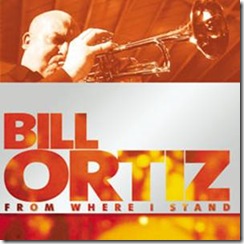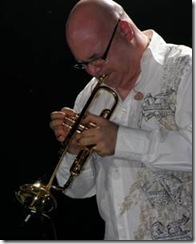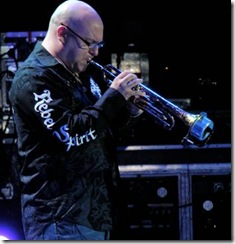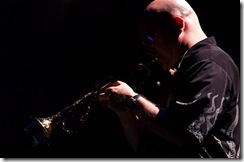Artist: Bill Ortiz
Recording: From Where I Stand
Label: Tangent Records
Author: Ed Jennings – musicofourheart@gmail.com
 Bill Ortiz’s debut CD, From Where I Stand is positioned as “An amazing mix of Neo-Soul, R&B and Nu-Jazz, from the trumpet player of Santana.”
Bill Ortiz’s debut CD, From Where I Stand is positioned as “An amazing mix of Neo-Soul, R&B and Nu-Jazz, from the trumpet player of Santana.”
Listeners are in for a unique experience of sounds and vibrations awaiting them on From Where I Stand. There is a mature depth to the soundscapes mined by established musician, composer, producer Bill Ortiz. Bill’s collaborations with San Francisco based co-producers, Lloyd (The Platinum Finger) Richmond and Steffen Franz (Stand Out Selector) yields a positive, diversified result. This audio CD will take you to new places; exposing you to beats, rhythms you’ve been longing to hear. Let’s examine the meaning of the musical genres and qualify those trends in relationship to the recorded tracks.
Neo-soul is a musical genre that fuses contemporary R&B and 1970s-style soul with the elements of hip-hop. Neo-Soul music is essentially modern-day soul music, with fashionable attitudes and sensibilities. It differs from contemporary R&B in that it’s obviously more soulful, and it also tends to have deeper messages and meanings than typical current R&B.
Nu-Jazz is a new era in music, blending ethereal soundscapes with hypnotic rhythms and sensuous instrumentals.
(The tracks reviewed are categorized Neo-Soul, Nu-Jazz and R&B with the following symbols.)
Neo-Soul = n§, Nu-Jazz = √∫, Rhythm & Blues = R/ß
Right from the first note of the initial track AyeJaye n§, you know where you stand with your musical guide Bill Ortiz. You are swept away on a magic carpet ride of orchestrated funk. Very quickly, Santana band mates, Benny Rietveld, (Bass) and Karl Perazzo (Percussion), pick up the rhythm on this track carrying you in a danceable direction. Bill Ortiz steps right in on top adding a rich layer of trumpet sounds. The various well-sequenced samples and audio effects round out this tune.
Little Sister, Little Brother R/ß is reminiscent of an old soul standard laden with honey. Regina Espinoza’s vocals intermix with the instrumental mood like a well-steeped late night cup of tea. The more you sip of this blend the more relaxed you become.
The songwriting/production partnership with Lloyd (The Platinum Finger) Richmond reaches a high point with Ease My Mind n§. The track does just what it sets out to accomplish by creating a mellow groove that puts you right at ease. Its like old friends who haven’t seen each other in awhile falling right back in step naturally as if no time has passed. Kenny Byars (Vocals and Song Co-Author) adds the right touch of modern soul with his spirited voice. Bill Ortiz’s trumpet playing echoes the sentiment expressed with extra flourish.
The instrumental track, Full Circle √∫ exhibits Bill Ortiz’s versatile skills with the trumpet, Arp Synth, Moog Bass, and samples. It’s a lively, upbeat composition smartly complemented by the other musicians onboard Peter Horvath (Wurlitzer Piano), Jubu Smith (Guitar), Sly Randolph (Drums, Midi Drums) and Jesus Diaz (Congas Bata, Percussion).
Slip Into This n§ starts off sounding like an old vinyl record to help in the transition from vintage soul to neo-soul. With no hesitation the funk builds then sustains itself throughout the track. Mone’t Owens provides just the right saucy soulstress vocal to spice up this selection with a repeatable chorus.
“Let go, relax your mind, unwind and slip into it”
Don’t worry if you felt that this track was too short or that you didn’t get enough pleasure from Slip Into This. Three tracks later we are treated to a hip-hop/rap remix, Slip Into It (Yay Area Remix) n§, with Mone’t’s vocals treating us again. She is joined vocally by Joshua Richmond Durham aka Fivehunnet Rap as MC.
Judgment Day is infectious as a rescaled, fast-clip, reggae tune with Bill Ortiz playing flugelhorn and muted trumpet. A little later on Judgment Day morphs into a dub track, Judgment Dub (Ras Dru Remix) with Rocker-T on vocals and lyrics, Ras Dru on Nybingi Drums. The dub track evidences how diverse a recording From Where I Stand truly is.
In Every Breath n§ is a tribute to the late soul musician Donny Hathaway. Church Boy performs the vocals over a well-crafted, measured jazz instrumental riff. The track then shifts to a soul funk that personifies the classic touch of vocals, piano and keyboards that are signature Donny Hathaway.
I Still Believe is an inspirational track that closes out the recording. It features vocalist Linda Tillery invoking a charismatic spoken word rendition of Dr. Martin Luther King Jr.’s Nobel Peace Prize acceptance speech from Oslo, Norway (1964). The music that embellishes the architect of peace’s words strengthens how timeless Dr. Martin Luther King Jr.’s speech is 45 years later. It is a fitting way to end From Where I Stand as the truth rings out a poetic wisdom that encircles every heart that listens.
Interview with Bill Ortiz, conducted on Tuesday, June 30, 2009
Ed Jennings, Interviewer – musicofourheart@gmail.com
Ed: Bill, I love your new album, From Where I Stand, I was pleasantly surprised by it. I feel the dimensionality of the recording is uniquely diverse and that your music is a very replay able work of listenable art.
Bill: Thank you. Hopefully this CD has a thread of identity with my voice as a trumpet player throughout all the different tracks. I started playing gigs professionally in my high school years, which was in the mid 70’s. During that era the music business wasn’t so compartmentalized as it can be now. Many jazz musicians were experimenting with other genres, blending their music together with R&B, funk, rock and other styles. In addition, it was also a very important moment, not only in music, but also in other aspects of cultures, with the tail end of the civil rights movement, the women’s rights movement. It was generally a very progressive time in the culture of San Francisco as well as the country.
When I first started playing gigs, pretty much all the musicians I was playing with were interested in playing all kinds of different music. Whether it was blues, R&B, jazz or whatever, it didn’t matter. It all comes from the same place anyway.
Ed: How did you choose the musicians you wanted to record and play with?
Bill: For the most part they were people that I was playing with at the time. Generally, the musicians I picked were the ones that I knew could deliver the sound and direction I wanted for that particular song. I know a whole lot of great musicians, and sometimes it’s not a matter of whether a person can play or not, it’s if they are right for the song. You want to have somebody that’s going to know where you’re going with the composition, and have the common vocabulary with you to bring out what you are looking for in the song.
In addition, in order to properly support your solo, it helps if they understand your conception and direction as a soloist. This stems from having that common musical view to understand where you’re going.
The guitar player I used on most of the tracks was John “Jubu” Smith, a great musician out of Oakland originally. I started out working with Jubu with Peter Apfelbaum and the Hieroglyphics Ensemble. After that, we worked together for a few years with the R&B soul band, Tony! Toni! Toné! I believe he started out as a gospel and blues player early on, but very quickly became a superb jazz musician-now of course he’s just a complete musician. It was just a no-brainer with his playing providing the certain element of what his voice brought to the table.
Ed: On the first track, AyeJaye, I like how you have Karl Perazzo (Percussion) and Benny Reitveld (Bass) from the New Santana on board. It’s a nice segue from the major work that you do with the New Santana Band.
 Bill: Right. The funny thing is that Karl Perazzo and I have been playing together since I was like 20 or 21 and he was around 17, so we have a very long history of playing together, long before playing with Carlos. Benny Reitveld and I played together first in the mid 80’s with Pete Escovedo, after which he went off to play with Miles. We’ve had a long musical history as well.
Bill: Right. The funny thing is that Karl Perazzo and I have been playing together since I was like 20 or 21 and he was around 17, so we have a very long history of playing together, long before playing with Carlos. Benny Reitveld and I played together first in the mid 80’s with Pete Escovedo, after which he went off to play with Miles. We’ve had a long musical history as well.
Ed: How long have you been carrying some of these songs and sounds inside of you before you put them onto the recording?
It’s taken me four or five years to get this done because I’ve been so busy working with Carlos Santana on the road. Few of these songs might pre-date that a little bit as far as when they were first written, but pretty much I’ve been working on it the last four or five years.
If I hadn’t been so fortunate to be the road as much with Carlos, I would’ve finished the project quicker, but I’ll take that trade off any day. When you’re traveling so much and you’re home for a month and then gone for a month, it requires balance. It’s of course, a great honor and joy to play with Carlos so you get to it when you’re able to.
I have say I’m blessed right now to have some really great people working with me on a business level. I have a good friend of mine that has his own distribution company. His name is Steffen Franz and his company is IDC. We also co-produced two tracks on the album. It’s a rare thing in the music business when you have someone that is not only interested in the numbers and the pure business aspect, but is also on the same page of what you’re doing artistically. Steffen is supportive of independent musicians trying to make a statement musically and otherwise. I’ve also been fortunate to work with Ben Lang, Christopher Austria, Haley Meijer, Kurt Kunselman all also at IDC, publicist Christopher Buttner of PRthatRocks, and radio promoters Adam Leibovitz of ASL Music Media and Brian Gerhard of Massive Music America.
Ed: Your timing could be good as there appears to be a richer vein of jazz being mined and explored by listeners right now. I think your recording will do well with all the different tracks that I hear. It’s such a different time of music distribution and music listening. You never know what’s going to click with the audience that’s out there.
Bill: Yes. Things have changed so much over the last couple of years the way independent artists and independent record companies have a little stronger footing now, especially with the rise of MySpace, Twitter, imeem, ReverbNation and Facebook. In addition to standard advertising and distribution, the fact that you can be up in all these sites and tie people immediately into iTunes or CD Baby or whatever music social networking site that you’re working with is a big plus for the independent artist.
I just got word from Steffen today that From Where I Stand is available on iTunes as of this morning, which is great. The official release isn’t until July 14th, but part of the plan is to be up a couple weeks before the official release just to get everything moving, and get a feel for initial interest and other related activities.
Ed: I’m really pleased to see how many people you have become friends with already on Facebook, which is going to be a great catalyst for you.
Bill: It’s really quick. Facebook is great. MySpace is fun because you send out all these friend requests and you’re able to not only connect with people who might buy your new music, but you become aware of the incredible amount of great music all over the place that is grass roots of any kind of music. You hear reggae from Australia or hip-hop from Finland and it’s just incredible stuff.
It’s nice to have ways now for the public to not only to listen artist’s music but also to connect with the artist themselves. The social network sites create an option for artists not to be so removed inside their little ivory towers.
Basically, I kind of look at the music thing the same as Carlos. You get to the point in your life when you really value the bigger picture, and music is one of the few things that can balance the scales. It’s important to me to put something out there with a positive and unifying nature in a time that is starving for it.
Ed: You’re very proud of the I Still Believe track. Your influence for the song, is it from the days of Dr. Martin Luther King Jr. or is it more because when you are with Carlos Santana you’re very focused, as he is, with being an architect of peace?
 Bill: I think it’s all of it. First of all, I’m old enough to have seen first hand as a kid the impact of Dr. King’s life and his passing, and what the strength of his words accomplished for the world. To be able to take those words, which are as much or even more relevant now, and put them out there again in a time that they are needed now more than ever, it’s an honor. So that’s part it.
Bill: I think it’s all of it. First of all, I’m old enough to have seen first hand as a kid the impact of Dr. King’s life and his passing, and what the strength of his words accomplished for the world. To be able to take those words, which are as much or even more relevant now, and put them out there again in a time that they are needed now more than ever, it’s an honor. So that’s part it.
Part of it also I was touching on before, Carlos talks about music being a healing force which brings people together. You see it at our concerts, when people are listening to our music it’s touching their soul and transcends language, religion or culture.
If you take it a step farther, you then see it as an artist, that it’s not the ego. It doesn’t really even play a role but gets in the way instead. To me, it’s not about the actors, it’s about the act, and at that point it’s almost like you’re a conduit of something that comes from outside of you and through you. Whether you want to define that as pure creativity, divinity or whatever, you connect with that. It’s something definitely that is beyond yourself.
Ed: The song Judgment Day that is a reggae tune first and then is done as a dub mix second, Judgement Dub, I really like that combination. I liked when Warren Haynes and Gov’t Mule did a whole dub based recording, Mighty High. I always felt that was a great experiment/risk for that jam band to take. Then to hear you do that treatment on your recording I thought was equal validation of dub as a re-mix experiment.
Bill: Thank you. It was something actually I kind of thought of doing maybe a couple of weeks before I was going to master. I really like when artists release not only their standard release, but dub releases as well, such as Garvey’s Ghost, by Burning Spear.
I liked what Branford Marsalis did on his first Buckshot Lefonque record. He had one song where they had two or three different re-mixes of the same song. It’s a way of taking a look at an object from different angles and stressing different things on it. If you’re listening to the two versions of Judgment Day, it’s the same song, but it’s a whole different interpretation of it. I was blessed to have the reggae artist Rocker-T provide some great lyrics and vocals, as well as have engineer and producer Ras Dru providing his vision with a great re-mix plus playing Nyahbingi drums.
Ed: The song Slip Into This, the seventh track on the CD, it starts off like an old vinyl record. Was that a vintage sound you were trying to achieve on behalf of the listener?
Bill: I worked with a Bay area writer on that particular tune whose name is Lloyd Richmond. He’s an incredibly talented and gifted writer and producer. We worked on a number of tunes on the record. That was a song he wrote and co-produced with me, it was his idea to throw in the vinyl sample. It ties in with how he and I were hearing not only that particular song but also the overall record. You take different influences, put them into a funnel and have them come out the bottom as your sound.
Taking elements of great classic R & B and soul music of the 60’s and 70’s and incorporating it with straight-ahead jazz, hip hop, neo-soul, and everything from the John Coltrane to Donny Hathaway, that was the concept. Therefore, the vinyl noise was kind of a nod to that classic period of R&B and jazz.
Ed: How much influence has nine years of playing with Santana had on the shape and sound of your recording?
Bill: Playing with Carlos had an influence on my improvising. When I started working with him in 2000, obviously, I was already well defined as far as my sound and my concept. But he has a way, not unlike Wayne Shorter and Miles Davis, of peeling away unnecessary crap in your playing and being more efficient with what you play. Every note you play means something, not preconceived, but just being very focused and every note meaning something.
I’ve never been the musician that was the “look at me, look at me” type. When I’m soloing I don’t to try to play on top of a groove, where the music stays the same and you’re pretty much just using that as a vehicle to play on top of. I’d rather play within the groove. That’s one of the things early Weather Report was doing, the role between the soloist and the ensemble becoming a little blurred. I love the organic nature of that, so even if you’re the soloist, there’s more conversation going on between people that are playing with you, and the music is different every night. I love spontaneous musical events. It’s enjoyable creating texture and moods more than creating a canvas for me to showcase myself on. Both approaches are valid and there are musicians who can do that much better than I
Ed: I don’t think a lot of people understand how hard everybody works with rehearsals prior to the show. I’m sure you probably had to put in some practice time before Europe because you don’t just walk out to the concert stage and step right into it.
Bill: In addition to that, just playing trumpet is a very demanding instrument. In a way it’s like you’re an athlete. If you don’t practice every day, you lose your control of your embouchure and then that’s it. I think Dizzy Gillespie was once quoted saying, “If you miss one day you know it. If you miss two days everybody knows it.” And it’s true.
It’s always a challenge on the road playing enough to keep my chops in tiptop shape so I don’t get a little rusty. So as far as the hard work we do, it’s not only the work that we do on stage and the rehearsals- it’s the years of playing the trumpet to get to the point of being having the skill set to handle the requirements of the job.
Ed: Bill, one of my favorite moments of you on video is the Supernatural DVD when you walk out the shadows during the rehearsals to watch Wayne Shorter play.
Bill: I can remember that moment. Since that day we’ve been blessed with playing with Wayne a number of times, such as touring Japan with him and Herbie Hancock during the Emissaries Of Peace Tour in 2005. But that was the first time I had played with him, so it was an incredible treat to see one of my heroes doing what he does.
You can learn a lot by the intangibles, how even before Wayne starts playing, how he approaches the moment. Through watching him I got a different level perspective of his thought process. I think at that moment it was a rehearsal, and I wasn’t aware that they were filming. I just walked by and they were playing and it was like, “Okay, here I am. I’m going to sit here listen to this moment of magic now.”
Ed: Tell me about the music you play when you’re not touring or recording with Santana.
Bill: Besides playing my own music I also work with an excellent jazz singer named Lavay Smith . She’s a Bay area person with a band co-led by her pianist Chris Siebert, called Lavay Smith & Her Red Hot Skillet Lickers. I have a whole lot of fun playing with that band. Their basic approach is jazz and blues from the 40’s through the 60’s, with a lot of their music being influenced Ray Charles, Duke Ellington, Count Basie and Dizzy Gillespie tunes, and stuff like that. They have some really nice four horn arrangements, done by Chris Seibert, as well as David Berger , who does arrangements for Lincoln Center.
I also work with Karl Perazzo and the great conga player/educator Mike Spiro, who co-lead the Latin band, Conjunto Karabali . So, that’s a lot of fun. I do a lot of session work and freelance stuff, too. Hopefully with the CD coming out I’m going to be doing more and more of my own shows.
kx2p5eran4



2 Replies to “Bill Ortiz, From Where I Stand, CD Review and Interview”